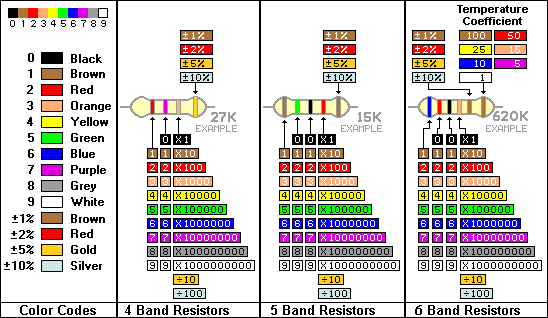How To Read Resistor Band Colors (4, 5, and 6 Bands)

Resistors are essential electronic components used to control the flow of electric current in a circuit. They are characterized by their resistance, which is measured in ohms (Ω).

The resistance of a resistor can be identified by reading the color bands on the resistor’s body. In this article, we will explain how to read resistor band colors for 4, 5, and 6-band resistors.

Although this is a useful skill to have, I found it annoying to keep referring to these charts every time. So, I went ahead and created a free iOS app to manage these calculations for me:

4-Band Resistor Color Code
The first two bands on a 4-band resistor represent the first and second digits of the resistance value. The third band represents the multiplier, and the fourth band represents the tolerance.
Here are the steps to follow when reading 4-band resistor color codes:
- Identify the first two bands’ colors and their corresponding values using a resistor color code chart (see above).
- Determine the multiplier using the third band’s color, which represents the number of zeros that follow the first two digits.
- Calculate the resistance value using the following formula:
Resistance (Ω) = (1st digit value x 10 + 2nd digit value) x Multiplier
Next, determine the tolerance by identifying the fourth band’s color. The tolerance represents the resistor’s allowable deviation from the specified resistance value.
5-Band Resistor Color Code
The first three bands on a 5-band resistor represent the first, second, and third digits of the resistance value. The fourth band represents the multiplier, and the fifth band represents the tolerance.
Here are the steps to follow when reading 5-band resistor color codes:
- Identify the first three bands’ colors and their corresponding values using a resistor color code chart.
- Determine the multiplier using the fourth band’s color, which represents the number of zeros that follow the first three digits.
- Calculate the resistance value using the following formula:
Resistance (Ω) = (1st digit value x 100 + 2nd digit value x 10 + 3rd digit value) x Multiplier
Lastly, determine the tolerance by identifying the fifth band’s color.
6-Band Resistor Color Code
The first three bands on a 6-band resistor represent the first, second, and third digits of the resistance value. The fourth band represents the multiplier, the fifth band represents the tolerance, and the sixth band represents the temperature coefficient. Here are the steps to follow when reading 6-band resistor color codes:
- Identify the first three bands’ colors and their corresponding values using a resistor color code chart.
- Determine the multiplier using the fourth band’s color, which represents the number of zeros that follow the first three digits.
- Calculate the resistance value using the following formula:
Resistance (Ω) = (1st digit value x 100 + 2nd digit value x 10 + 3rd digit value) x Multiplier
Next, determine the tolerance by identifying the fifth band’s color. Finally, determine the temperature coefficient by identifying the sixth band’s color. The temperature coefficient represents the resistor’s change in resistance as the temperature changes.
Reading resistor band colors can be confusing, but with the right tools and knowledge, it becomes a simple task. Whether you are working with 4, 5, or 6-band resistors, it is essential to use a resistor color code chart to accurately determine the resistance value, multiplier, tolerance, and temperature coefficient.
By following the steps outlined in this article, you can confidently work with resistors and ensure that your circuits are functioning as intended. If you can’t be bothered, like me, feel free to use any of the online/mobile calculators instead:

